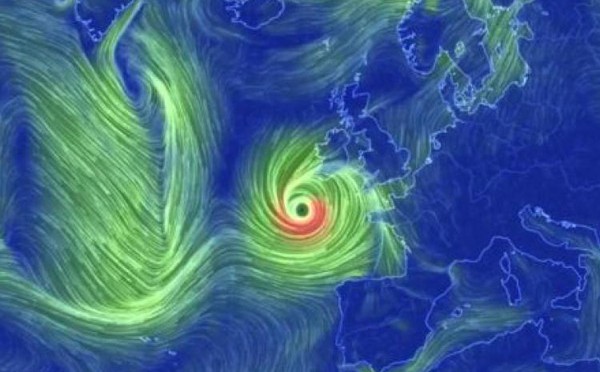It’s been a rather tumultuous summer in Ireland, weather-wise. July was the wettest in the country since records began. And August has seen its fair share of stormy conditions. Extreme weather events, especially powerful storms, can have a profound impact on our environment and daily lives. Beyond the immediate destruction they can cause, these severe weather events can also influence the spread of infectious diseases. The intricate interplay between weather patterns and disease transmission is a complex area of study that requires a holistic understanding of both meteorological and epidemiological factors. In this article, we delve into the ways in which extreme weather, particularly storms, can affect the spread of infectious diseases and explore the strategies to mitigate their combined impact.
Disruption of Healthcare Infrastructure
One of the most apparent impacts of severe storms is the disruption of healthcare infrastructure. Power outages, flooding, and physical damage to healthcare facilities can hinder medical care delivery and access to essential treatments. This disruption can exacerbate disease transmission, particularly in the case of waterborne diseases like cholera and leptospirosis, which thrive in contaminated water sources. The inability to provide prompt medical care can lead to increased disease burden and poorer health outcomes.
Displacement of Populations
Extreme storms often result in forced evacuations and displacement of populations, leading to overcrowded temporary shelters or resettlement areas. These crowded living conditions provide fertile grounds for the rapid transmission of various infectious diseases, including respiratory infections like influenza and tuberculosis, as well as vector-borne diseases such as dengue fever and malaria. Close proximity, poor sanitation, and limited access to clean water further facilitate disease transmission within these vulnerable populations. Additionally, prevention methods for diseases transmitted through fleas also become exacerbated by these kind of weather events.
Changes in Vector Dynamics
Vector-borne diseases, those transmitted by insects like mosquitoes and ticks, are highly sensitive to weather conditions. Storms can modify local environments, creating pockets of stagnant water or damp habitats that support the breeding of disease-carrying vectors. Increased humidity and temperature can also promote the growth and survival of these vectors. For instance, hurricanes and heavy rainfall can create temporary breeding grounds for mosquitoes, resulting in spikes in diseases like West Nile virus and Zika virus.
Water Contamination
Floodwaters from extreme storms can lead to the contamination of water sources used for drinking, cooking, and bathing. This can introduce a host of waterborne diseases, including cholera, dysentery, and hepatitis A. Inadequate sanitation facilities and the mixing of sewage with floodwaters create a perfect storm for disease transmission. Even after the storm has passed, the lingering contamination can have long-lasting health consequences for communities.
Disrupted Disease Surveillance and Response
In the aftermath of a storm, disease surveillance and response systems can be severely hampered. Damage to communication networks and transportation infrastructure can hinder the collection and dissemination of vital health information. This delayed reporting and response can impede efforts to identify and contain disease outbreaks effectively. Additionally, the diversion of resources to address immediate disaster-related needs might detract from public health efforts, inadvertently promoting disease spread.
Mitigation Strategies
Preparedness and Response Plans: Governments and healthcare agencies should develop and implement robust preparedness and response plans that specifically address the intersection of extreme weather events and infectious disease outbreaks. These plans should include strategies for maintaining healthcare infrastructure, ensuring access to clean water, and facilitating disease surveillance even during emergencies.
Public Awareness and Education: Raising public awareness about the health risks associated with extreme weather events can encourage individuals to take preventive measures. This includes educating communities about safe water storage, proper hygiene practices, and the use of protective measures against disease-carrying vectors. The use of mosquito nets and repellents are also very useful in reducing exposure to many disease-carrying vectors.
Improved Infrastructure: Investing in resilient infrastructure that can withstand extreme weather events can help mitigate the impact of disruptions on healthcare services, water supply, and sanitation facilities. This can contribute to a more effective response to disease outbreaks in the aftermath of storms.
Vector Control Measures: Implementing effective vector control strategies, such as regular removal of standing water and the use of insecticides, can help curb the proliferation of disease-carrying vectors in the wake of storms.
Collaboration and International Support: Given that extreme weather events and infectious diseases often transcend borders, international collaboration and support are crucial. Sharing resources, expertise, and lessons learned can help affected regions respond more effectively to combined challenges.
The nexus of extreme weather events and infectious diseases poses a multifaceted challenge to public health. As the frequency and intensity of storms continue to rise due to climate change, understanding the complex interactions between meteorology and epidemiology becomes increasingly important. By implementing proactive measures, fostering collaboration, and promoting public awareness, we can work towards minimizing the adverse health impacts of extreme storms and creating more resilient communities in the face of these combined challenges.

